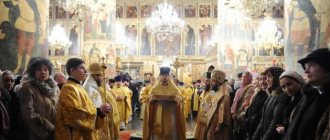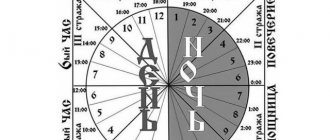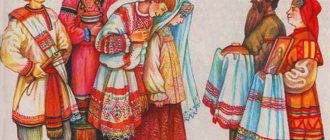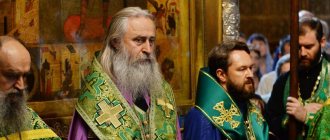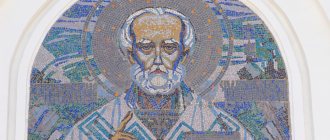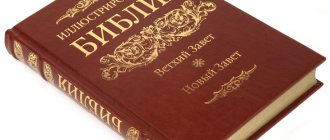Procedure
- Greeting from the priest: “Blessed is the Kingdom of the Father and the Son and the Holy Spirit, now and ever, and unto ages of ages.”
- Litany (“Let us pray to the Lord in peace”): about peace, the salvation of souls, this temple, country, city, various categories of people.
- Antiphon ("Bless my soul the Lord")
- Litany (“Packs and Packs”)
- Doxology
- Song to Jesus Christ
- "The Beatitudes" (from the Gospels)
- Trisagion
- Wishes for peace.
- Prokeimenon (Psalm of David)
- Reading of the Apostle.
- Reading the Gospel.
- Release of the catechumens.
- Cherubic Song
- Consecration of gifts.
- Symbol of faith
- Anaphora
- Seraphim's Song.
- Our Father
- Participle
The Divine Liturgy is the central Christian service. It is during the Liturgy that the main sacrament of Christianity occurs - the transubstantiation of bread and wine into the Body of Christ, which the believers partake of at the end of the service.
In modern practice, the Liturgy is celebrated in the morning. It can be served on any day except Good Friday, Wednesdays and Fridays of Cheese Week, Tuesday and Thursday of the first six weeks of Lent, as well as Fridays before Christmas and Epiphany if these holidays fall on Sunday.
In the Orthodox Church there are three rites of the Liturgy: the Liturgy of John Chrysostom, the Liturgy of Basil the Great and the Liturgy of the Presanctified Gifts.
The Liturgy of St. John Chrysostom is celebrated most often.
The Liturgy of Basil the Great is served 10 times a year: on Christmas and Epiphany Eves on January 6 and 18), on the day of remembrance of the saint himself (January 14), on the first five Sundays of Great Lent, on Maundy Thursday and Maundy Saturday. On Christmas Eve, Maundy Thursday and Holy Saturday, the Liturgy joins Vespers. In modern practice, it is performed together with Vespers in the morning, but according to the rules it must be served in the evening: on Christmas Eve and Holy Saturday, the Liturgy refers to the next liturgical day, that is, in fact, it is the first festive service of Christmas, Epiphany or Easter, and the Liturgy of Maundy Thursday is celebrated on the memory of the Last Supper - that is, the evening meal, the dinner of Christ with the disciples, at which the sacrament of the Eucharist was established.
The Liturgy of the Presanctified Gifts is celebrated on Wednesdays and Fridays of Great Lent, and on Mondays, Tuesdays and Wednesdays of Holy Week. It is not a full Liturgy: at this service the transubstantiation of bread and wine into the Body of Christ is not performed, but believers partake of the Gifts that were consecrated at one of the previous Liturgies.
Order of celebration of the Liturgy of John Chrysostom and Basil the Great
The Liturgy consists of three parts: proskomedia, Liturgy of the Catechumens and Liturgy of the Faithful.
Proskomedia
Proskomedia - translated from Greek means “offering”: five liturgical breads (prosphora), wine and water are sacrificed to God. This is the preparatory part of the Divine Liturgy, performed during the reading of the hours.
The priest takes five large prosphoras, according to the number of five loaves with which Christ fed five thousand people. Particles are taken out of the prosphora in honor of Christ, the Mother of God, saints and all Orthodox Christians. The part taken out in the name of Jesus Christ is called the lamb; it is this part that is divided into parts and given to believers during communion. The removed particles are placed on the paten - a special dish for the Holy Gifts. A star is placed on top, on top of which an air is placed
x (special bedspread). Next to the paten on the altar there is a cup (chalice) with wine and water poured into them.
The remaining part of the prosphora from which the lamb was taken is called antidoron and is distributed at the end of the Liturgy to those who did not receive communion. You can eat antidor only in the temple, on an empty stomach.
Small prosphoras are also brought to the proskomedia according to the number of custom-made notes about health and repose. The priest takes out particles from them, reading the names on the notes. After the Liturgy, these prosphora, without the removed particle, are distributed to those who submitted notes.
At the end of the proskomedia, the priest censes the prepared gifts with prayer.
Liturgy of the Catechumens
The Liturgy of the Catechumens is the first part of the Liturgy. Unlike the second part, the Liturgy of the Faithful, in ancient times it was attended by those who had not yet received baptism - the catechumens.
The Liturgy of the Catechumens begins with the exclamations of the deacon and priest: “Bless, Master” - “Blessed is the Kingdom of the Father, and the Son, and the Holy Spirit, now and ever, and unto the ages of ages.”
Then the deacon reads the great litany, during which he asks God for the salvation of those gathered here and all Orthodox Christians, for the goodness of the air and the abundance of earthly fruits, for the country, its authorities and army.
Then follow three antiphons - chants composed of verses of psalms, which are sung alternately by the right and left choir. Antiphons vary depending on the day of the week (weekday or Sunday) or holiday.
After the second antiphon, the chant “Only Begotten Son...” is sung, in which believers ask Christ to save and have mercy on them. This chant contains a brief summary of the Orthodox teaching about Jesus Christ: His eternal birth from the Father, incarnation from the Virgin Mary, crucifixion and resurrection.
Then the third antiphon is sung - blessed: excerpts from the Gospel listing the beatitudes. Along with the Gospel verses, excerpts from the canon of the holiday or saint whose memory is celebrated on this day are sung.
After the antiphons, the entrance with the Gospel is made (small entrance), which symbolizes Christ's entrance to preach. The clergy with the altar Gospel leave the altar through the northern doors, then enter it through the royal doors.
After the entrance, the modified part of the Liturgy follows - the troparia and kontakia of today's saint or holiday, day of the week, saint or holiday in honor of which the temple is consecrated are sung. The Trisagion is sung: “Holy God, Holy Mighty, Holy Immortal, have mercy on us.”
Then the Holy Scripture is read: the Apostle (an excerpt from the message of one of the apostles or from the Acts of the Holy Apostles) and the Gospel. After this, the priest delivers a sermon explaining the meaning of the Scriptures read. In some churches, the sermon is not delivered at this moment, but later, before the communion of the laity.
After reading Scripture, the deacon reads a special (that is, double, doubly zealous) litany, in which he asks God for mercy for all those praying, for the authorities and army of the country, and also prays for the repose of the departed. During this litany, simple notes about health and repose are read (in contrast to the custom notes that were read at the altar during the proskomedia).
After this, a prayer is read for the catechumens, and then the deacon exclaims: “Catechumens, come forth.” In ancient times, at this time, everyone preparing for baptism left the church, and the remainder of the service - the Liturgy of the Faithful - was performed with the doors locked.
Liturgy of the Faithful
The Liturgy of the Faithful begins with two short litanies. The royal doors open and the choir begins to sing the Cherubic Song. During the Cherubim, the Great Entrance takes place: the priest and deacon take the Holy Gifts from the altar and bring them to the pulpit through the northern doors: the deacon carries a paten with pieces of prosphora taken out, placing it on his head, the priest - a cup of wine in his hands. After this, the priest and deacon say a prayer for the patriarch and all Orthodox Christians and bring the Holy Gifts to the altar through the royal doors. The gifts are placed on the throne, the royal doors are closed, and the curtain is drawn behind them.
After the great entrance there follows a litany of petition, then the whole temple sings the Creed in chorus.
After singing the Creed, the priest in the altar begins to say the Eucharistic prayers, according to which the Holy Gifts are transubstantiated into the Body and Blood of Christ. These prayers are said quietly, although they can be heard by the faithful from the altar. The priest proclaims certain phrases loudly, so that all those praying in the temple can hear them. After the consecration of the Gifts, the priest remembers all the saints who have become famous in the Orthodox Church, especially the Blessed Virgin. The choir sings the chant “It is worthy to eat...” (if the Liturgy of St. John Chrysostom is being served) or “Every creature rejoices in You, O grace-filled one” (if the Liturgy of St. Basil the Great is being served), on major holidays it can be replaced by another chant - the hymn. The priest in the altar quietly prays for the dead and the living. A petition for the health of the patriarch and the ruling bishop (bishop, archbishop or metropolitan) is read out loud.
Then the priest blesses those praying, the deacon reads a petitionary litany, in which he asks God for mercies. Then the whole temple sings “Our Father...” in unison.
After this, the priest blesses those gathered with the words “Peace to all.” The deacon exclaims: “Let’s get out!” Priest: “Holy to holies!” This means that the Holy Gifts can only be given to saints. The choir answers: “There is only one Holy One, one Lord Jesus Christ, to the glory of God the Father. Amen,” which means: only Christ is fully holy, while the rest begin to partake of the holy gifts with the awareness of their unworthiness. After this, the clergy receive communion at the altar.
While the clergy are receiving communion, the choir sings a communion verse and some kind of chant. Also at this time, the priest can deliver a sermon (if it was not read immediately after reading the Scriptures) or the reader reads prayers from the sequence for Holy Communion, to help those who did not have time to read them in the morning.
Then the Cup is taken out to the worshipers. The deacon exclaims: “Come with fear and faith!” The priest reads a prayer before communion. In Russian it sounds like this: “I believe, Lord, and confess that You are truly Christ the Savior, the Son of the Living God, who came into the world to save sinners, of whom I am the first. I also believe that in this Chalice there really is Your Most Pure Body and Your Precious Blood. I pray to You: have mercy on me and forgive me my sins, committed voluntarily or involuntarily, in word or deed, consciously or out of ignorance, and grant me, not as a condemnation, to partake of Your Most Pure Mysteries, but for the remission of sins and eternal life. Amen. Son of God, accept me as a communicant of Your Last Supper, because I will not tell Your enemies about Your sacrament and will not give You the treacherous kiss of Judas, but, like a thief, I will say: remember me, Lord, in Your Kingdom. Let the communion of Your Holy Mysteries be not for judgment or condemnation for me, Lord, but for the healing of soul and body.”
After this, those praying approach the Chalice and take Communion. When everyone has received communion, the Chalice is taken to the altar. The priest immerses all the removed pieces of prosphora into it with a prayer that the Blood of the Lord Jesus Christ will wash away the sins of everyone for whom they prayed at the Liturgy. The choir sings prayers of thanks at this time. Then the deacon pronounces a short litany, and the priest reads the prayer behind the pulpit. After her, he blesses those praying for the last time and says goodbye, holding a cross in his hand. After this, everyone present in the temple comes up to venerate the cross. This ends the service.
Commitment days
The Liturgy of Basil the Great is celebrated in the Orthodox Church 10 times a year:
- Memorial Day of St. Basil the Great January 1 (14);
- the eternity of the holidays of the Nativity of Christ and Epiphany (Fig. 1a) or on the very day of these holidays, if their eves fall on Saturday or Sunday (Fig. 1b, c);
- 1st, 2nd, 3rd, 4th and 5th Sundays of Lent;
- Maundy Thursday and Holy Saturday during Holy Week.
PREPARATION AND CONSECTION OF GIFTS FOR THE LITURGY OF THE PRECONACTED GIFTS
At those Liturgies during which the Gifts for the Liturgy of the Presanctified Gifts are consecrated, a larger number of prosphoras are used at the proskomedia than usual, namely, as much as is prepared for the consecration of the Lambs for the Liturgy of the Presanctified Gifts, for the Lamb for each Liturgy is taken from a special prosphora. The Holy Lamb for the Liturgy of the Presanctified Gifts is prepared at the proskomedia at the same time that the Lamb is prepared for the Liturgy celebrated on the same day. At the proskomedia, the priest “takes out, eats and perforates the first Lamb,” then pronounces the same words and performs the same actions on the Lambs prepared for the Liturgy of the Presanctified Gifts; then he places them all on the paten and covers them with covers. During the consecration of the Gifts, after invoking the Holy Spirit, the priest pronounces the perfecting words over all the Lambs simultaneously: “Create this bread,” and does not say in the plural: “This bread,” because Christ alone is, both in this and in other bread. When the priest offers the Holy Gifts, he also offers the Lamb intended for the Liturgy of the Presanctified Gifts. Then, when the priest breaks the first Holy Bread, he places a particle of it (IS) into the chalice and pours warmth into the chalice. Next, he places on his left hand (on his lip) the Holy Lamb, prepared for the Liturgy of the Presanctified Gifts, and with his right hand he takes a spoon and, having dipped it in the Most Pure Blood, touches the Holy Lamb crosswise with it, touching the soft side along the cross-shaped cut. The Most Pure Body of Christ, united with the Most Pure Blood, is placed in the tabernacle and preserved until the Liturgy of the Presanctified Gifts.
Differences between the rites of the liturgy
The order, content and action of the liturgy of Basil the Great are the same as that of the liturgy of John Chrysostom, but with the following features:
- at the proskomedia and dismissal, instead of the name of John Chrysostom, the name of Basil the Great is remembered.
- the prayer for the catechumens and each subsequent prayer of the priest here has a different text, as a rule, 2-4 times more extensive;
- the hymns here have a longer chanting so that the priest has time to read the prayers, in particular the Eucharistic prayer, which is about 4 times longer compared to the corresponding prayer at the Liturgy of St. John Chrysostom;
- in the second part of the Eucharistic prayer, the priest adds aloud the words “to His saints, disciple and apostle, rivers...” before the exclamations “... take, eat” and “... drink from it, all of you”;
- instead of the prayer “It is worthy to eat,” the prayer “Rejoices in You” is sung, with the exception of a few cases described in the next section.
Liturgy is the main Christian service
Liturgy is a special divine service that occupies a central place in the life of the Church. All sacred actions and prayers of this service are focused on preparation for the Sacrament of the Eucharist (from the Greek “thanksgiving”) and the very reception of the Body and Blood of Jesus Christ. For the first time, the Liturgy (Eucharist) was celebrated by the Savior Himself together with His apostles during the Last Supper. This happened immediately before the suffering and death of Jesus Christ, as evidenced by all the Evangelists, as well as the Apostle Paul.
The high importance of Communion for the spiritual life of every Christian cannot be overestimated. The Eucharist is a bloodless sacrifice “for all and for all,” which was offered by the Lord Jesus Christ. And according to the Savior’s behest, we create it in memory of this sacrifice.
“Liturgy is the wondrous gift of Jesus Christ. Liturgy is a bridge over which one can pass into eternal life.”
(John of Kronstadt, “My Life in Christ”).
Singing the Creed during the Divine Liturgy
